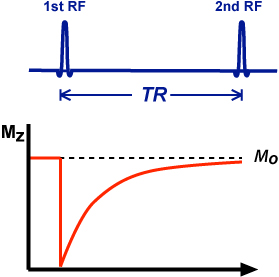MRI
Magnetic resonance imaging (MRI) is a medical imaging
technique used in radiology to form pictures of the anatomy and the
physiological processes of the body in both health and disease. MRI scanners
use strong magnetic fields, magnetic field gradients, and radio waves to
generate images of the organs in the body. MRI does not involve X-rays or the
use of ionizing radiation, which distinguishes it from CT or CAT scans and PET
scans. Magnetic resonance imaging is a medical application of nuclear magnetic
resonance (NMR). NMR can also be used for imaging in other NMR applications
such as NMR spectroscopy.
MRI (an abbreviation of magnetic resonance imaging) is an imaging modality that uses non-ionising radiation to create useful diagnostic images. MRI was initially called nuclear magnetic resonance (NMR) imaging after its early use for chemical analysis. The initial "nuclear" part was dropped about 25 years ago because of fears that people would think there was something radioactive involved, which there is not.
NMR was discovered simultaneously by two physicists, Felix Bloch and Edward Mills Purcell, just after the end of the Second World War. Bloch trained in quantum mechanics and was involved with atomic energy and then radar counter-measures. At the end of the war, he returned to his earlier work in the magnetic moment of the neutron. Purcell was involved with the development of microwave radar during the war then pursued radio waves for the evaluation of molecular and nuclear properties. They received the Nobel Prize in Physics in 1952 for this discovery.
MRI, the use of NMR to produce 2D images was accomplished by Paul Lauterbur, imaging water, and Sir Peter Mansfield who imaged the fingers of a research student, Andrew Maudsley in 1976. Maudsley continues to make a significant contribution to the development of MRI today. Raymond Damadian obtained human images a year later in 1977. Lauterbur and Mansfield received the Nobel Prize in Physiology or Medicine in 2003 for their development of MRI. This award was controversial in that the contributions of Damadian to the development of MRI were overlooked by the Nobel Committee.
In simple terms, an MRI scanner consists of a large, powerful magnet in which the patient lies. A radio wave antenna is used to send signals to the body and then receive signals back. These returning signals are converted into images by a computer attached to the scanner. Imaging of any part of the body can be obtained in any plane.







Comments
Post a Comment